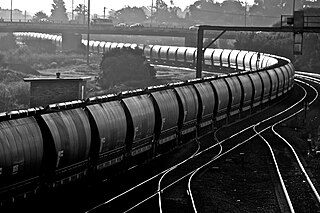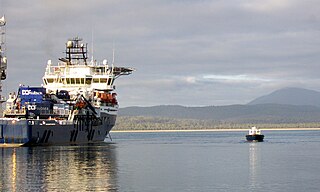
CityRail was a passenger railway brand operated by the State Rail Authority from 1989 to 2003 and by RailCorp from 2003 to 2013 with services in and around Sydney, Newcastle and Wollongong, the three largest cities in New South Wales, Australia. It was established in January 1989 and abolished in June 2013 when it was superseded by Sydney Trains and NSW TrainLink.

Port Kembla is a suburb of Wollongong 10 km south of the CBD and part of the Illawarra region of New South Wales. The suburb comprises a seaport, industrial complex, a small harbour foreshore nature reserve, and a small commercial sector. It is situated on the tip of Red Point: its first European sighting was by Captain James Cook in 1770. The name "Kembla" is an Aboriginal word meaning "plenty [of] wild fowl".
The State Rail Authority, a former statutory authority of the Government of New South Wales, operated and maintained railways in the Australian state of New South Wales from July 1980 until December 2003.

The State Transit Authority of New South Wales, also referred to as State Transit, was an agency of the Government of New South Wales operating bus services in Sydney. Superseding the Urban Transit Authority in 1989, it was also responsible for the provision of ferry services in Sydney until 2004 and bus and ferry services in Newcastle until 2017. It ceased trading after 2 April 2022 with its remaining operations to be contracted out by Transport for NSW to replacement operators.

The Port of Newcastle is a major seaport in the city of Newcastle, New South Wales, Australia. It is the world's largest coal port.

The Sydney Freight Network is a network of dedicated railway lines for freight in Sydney, Australia, linking the state's rural and interstate rail network with the city's main yard at Enfield and Port Botany. Its primary components are the Southern Sydney Freight Line (SSFL) and a line from Sefton to Enfield and Port Botany. The Network has been managed by the Australian Rail Track Corporation (ARTC) since 2012. Prior to the completion of the SSFL, it was managed by RailCorp as the Metropolitan Freight Network.

East Coast Heritage Rail is a not for profit company limited by guarantee formed in June 1985 as 3801 Limited to operate steam locomotive 3801 and its associated rolling stock. The company operated heritage train tours from 1986 until 2017, with operations recommencing in February 2019 under the new brand, East Coast Heritage Rail.

Barangaroo is an area of central Sydney, New South Wales, Australia. It is located on the north-western edge of the Sydney central business district and the southern end of the Sydney Harbour Bridge. It is part of the local government area of the City of Sydney. The area was used for fishing and hunting by Indigenous Australians prior to colonial settlement. The area is inclusive of The Hungry Mile, the name harbourside workers gave to the docklands area of Darling Harbour East during The Great Depression, where workers would walk from wharf to wharf in search of a job, often failing to find one.

An extensive multi-modal transport system serves the state of New South Wales, Australia. The lead government agency responsible for the network's operation and development is Transport for NSW.

The Hunter Valley Coal Chain (HVCC) is the chain of coal delivery in New South Wales, Australia from coal mines in the Hunter Region to the Port of Newcastle and domestic coal-fired power stations in the Hunter Valley. The HVCC essentially follows the path of the Hunter River travelling south-east from the mining areas in the Hunter Valley to Newcastle.

The Port of Eden is a small seaport situated in Twofold Bay, adjacent to the town of Eden, located in the South Coast region of New South Wales, Australia.

Mort's Dock is a former dry dock, slipway, and shipyard in Balmain, New South Wales, Australia. It was the first dry dock in Australia, opening for business in 1855 and closing more than a century later in 1959. The site is now parkland.

Port Botany is a deepwater seaport located in Botany Bay in Sydney, Australia. The port is dominated by trade in containerised manufactured products and, to a lesser extent, bulk liquid imports including petroleum and natural gas. It is one of Australia's largest container ports and is administered by NSW Ports which entered into a 99-year lease agreement with the Port Authority of New South Wales in May 2013.
NSW Maritime, the trading name of Maritime Authority of New South Wales, was an agency of the Government of New South Wales, Australia responsible for marine safety, regulation of commercial and recreational boating and oversight of port operations. The Authority had responsibility for marine incident investigation, including the causes of incidents involving shipping and commercial vessels and breaches of State or Commonwealth navigation laws. Incidents involving Sydney Ferries vessels are examined by the Office of Transport Safety Investigations, which is also responsible for investigations into incidents involving publicly owned rail and bus transport. The Authority was also responsible for property management of submerged lands in Sydney Harbour, Newcastle Harbour, Botany Bay and Port Kembla, and for providing strategic advice on ports and maritime matters to the NSW Government.

Glebe Island was a major port facility in Sydney Harbour and, in association with the adjacent White Bay facility, was the primary receiving venue for imported cars and dry bulk goods in the region until 2008. It is surrounded by White, Johnstons, and Rozelle Bays. Whilst retaining its original title as an "island", it has long been infilled to the shoreline of the suburb of Rozelle and connected by the Glebe Island Bridge to Pyrmont.

Transport for NSW (TfNSW) is a New South Wales government transport and road agency established on 1 November 2011. The agency is a different entity to the New South Wales Department of Transport, a department of the New South Wales Government and the ultimate parent entity of Transport for NSW.

Port Kembla is a man-made cargo port or artificial harbour, with an outer harbour protected by breakwaters and an inner harbour constructed by dredging, located in the Illawarra region of New South Wales, Australia.
The Victorian Ports Corporation (Melbourne) (VPCM) is a statutory authority of the Government of Victoria created to succeed the Port of Melbourne Corporation as the government regulator of shipping in Port Phillip Bay after the lease of the Port of Melbourne in 2016. In 2021, it was merged with the Victorian Regional Channels Authority into a new agency, Ports Victoria.
The coastal coal-carrying trade of New South Wales involved the shipping of coal—mainly for local consumption but also for export or coal bunkering—by sea to Sydney from the northern and southern coal fields of New South Wales. It took place in the 19th and 20th centuries. It should not be confused with the export coal trade, which still exists today. There was also an interstate trade, carrying coal and coke to other Australian states that did not have local sources of black coal.















